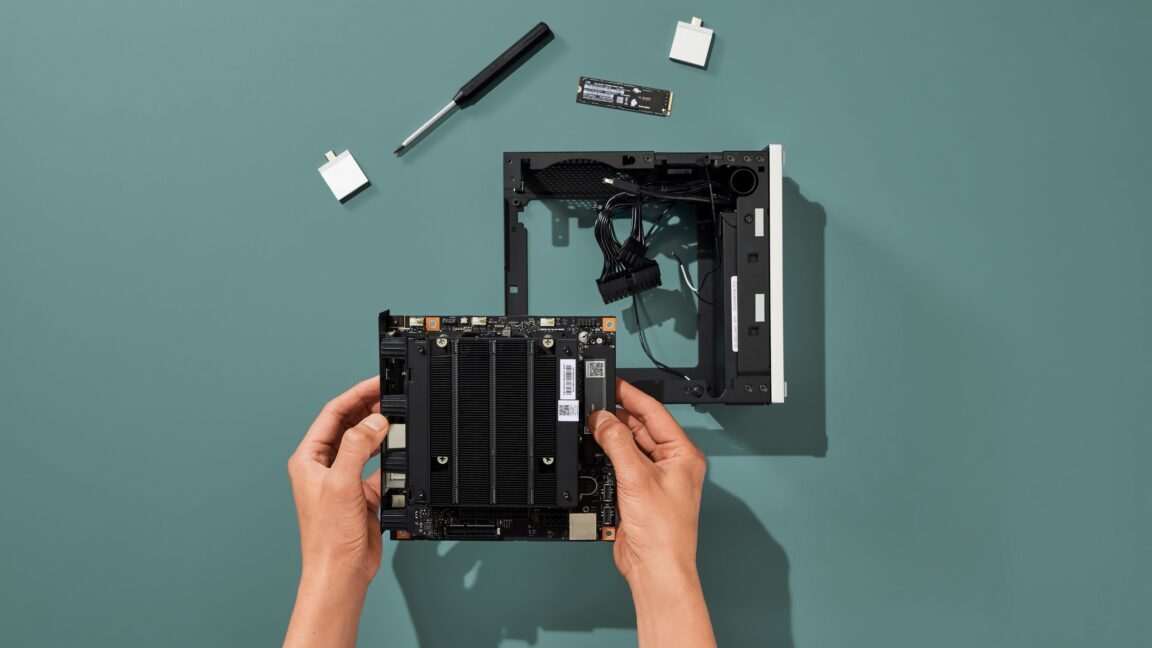Framework releasing a Mac Mini was certainly not on my bingo card for this year.
Ok, should I know who framework is? I’ve been a PC gamer since forever and I’ve never heard of this company.
They make repairable laptops.
repairable and upgradable*
I know it’s an absolutely banal nitpick, but I think it’s unfortunately a revelation in the current laptop market that ~90% of a laptop stays good for a really really long time, and the other 10% can be upgraded piecemeal as the need arises. Obviously this was never news to the Desktop world, but laptop manufacturers got away with claiming this was impossible for laptops in the name of efficiency and portability.
its modular like a desktop pc. you can fix it and upgrade piecemeal instead of junking it, also like a desktop. if you are a gamer you dont need to be in that common situation where the cpu still holds but the gpu is already oooolddd that usually happens on laptops.
I wasn’t prepared. I’ve been eyeing a mini for a while and this thing kills it on value compared to what I would get in a similar price point.
What alternatives were you considering, and how does the product from Framework compare?
Mac mini and studio. The overall power comparison remains to be seen but cost to spec ratio I would have had to spend over 6k and couldn’t have 16tb of memory, frameworks was around 3200.
I feel like this is a big miss by framework. Maybe I just don’t understand because I already own a Velka 3 that i used happily for years and building small form factor with standard parts seems better than what this is offering. Better as in better performance, aesthetics, space optimization, upgradeability - SFF is not a cheap or easy way to build a computer.
The biggest constraint building in the sub-5 liter format is GPU compatibility because not many manufacturers even make boards in the <180mm length category. Also can’t go much higher than 150-200 watts because cooling is so difficult. There are still options though, i rocked a PNY 1660 super for a long time, and the current most powerful option is a 4060ti. Although upgrades are limited to what manufacturers occasionally produce, it is upgradeable, and it is truly desktop performance.
On the CPU side, you can physically put in whatever CPU you want. The only limitation is that the cooler, alpenfohn black ridge or noctua l9a/l9i, probably won’t have a good time cooling 100+ watts without aggressive undervolting and power limits. 65 watts TDP still gives you a ryzen 7 9700x.
Motherboards have the SFF tax but are high quality in general. Flex ATX PSUs were a bit harder to find 5 or 6 years ago but now the black 600W enhance ENP is readily available from Velkase’s website. Drives and memory are completely standard. m.2 fits with the motherboard, 2.5in SATA also fits in one of the corners. Normal low profile DDR5 is replaceable / upgradeable.
What framework is releasing is more like a laptop board in a ~4 liter case and I really don’t like that in order to upgrade any part of CPU, GPU or memory you have to replace the entire board because it’s soldered on APU and not socketed or discrete components. Framework’s enclosure hasn’t been designed to hold a motherboard+discrete GPU and the board doesn’t have a PCIe slot if you wanted to attach a card via riser in another case. It could be worse but I don’t see this as a good use of development resources.
I think the biggest limiting factor for your mini PC will always be the VRAM and any workload that enjoys that fast RAM speed. Really, I think this mini PC from framework is only sensible for certain workloads. It was poised as a mobile chip and certainly is majorly power efficient. On the other hand I don’t think it is for large scaling but more for testing at home or working at home on the cheap. It isn’t something I expected from framework though as I expected them to maintain modularity and the only modularity here is the little USB cards and the 3D printed front panel designs lol
Edit
Personally I am in that niche market of high RAM speed. Also, access to high VRAM for occasional LLM testing. Though it is an AMD and I don’t know if am comfortable switching from Nvidia for that workload just yet. Renting a GPU is just barely cheap enough.
This is a standard a370 mini PC at a high price.
There’s Beelink, Minisforum, Aoostar and many others.
The AI max chips are a completely different platform, more than double the physical silicon size of most minipc chips.
Most miniPC vendors have already announced AI Max products:
https://www.gmktec.com/blog/gmktec-a-global-leader-in-ai-mini-pcs-unveils-the-amd-ryzen-ai-max-395
But Framework released it now.
Nope, they’re just available to pre-order with an estimate of shipping from Q3 this year. They’re not shipping now.
I just checked, the gmktec link above says that their product is supposed to ship in Q1-Q2 this year, earlier than framework’s.The person above you confidently posted that it’s shipping now and got an up vote despite being wrong.
I never understand people who confidently post wrong things that are easily googlable.
Xbox with the ability to run windows is what the article is basically saying.
Or linux.
This thing makes a whole lot of pricey workstations obsolete.
I think I need to give Linex a try again. I tried ubuntu in 2008 but found it too difficult to do the things I was used to doing on windows. I now have a bit more coding experience and will probably pick it up quicker
It’s gotten so much better since 2008. Ubuntu is good for servers, but probably not what you’re looking for on a desktop. And you really don’t need to have a coding background to use it, though it also depends on your use case.
I just recall trying to put music on an ipod in ubuntu was a nightmare
Probably still is, lol.
Apple stuff works best in the Apple ecosystem, though most of what works on Windows can work on linux.
Ive long given up on apple! I will do some research!
You don’t have to pick and choose, you can dual boot.
But the only thing I boot Windows for these days is gaming and Microsoft Teams. Linux has come a long way since 2008.
teams online client is good enough, too
I will look into it again!
What kind of workstations?
Any that needs a lot of VRAM and good CPU performance on a budget, but not necessarily the real time performance of a W7900 or whatever.
Love the downvotes for saying something that is in the article! Feels just like reddit!
Lmao the news about this desktop is strangling their website to the point of needing a 45 minute waiting list
The Lemmy Lick strikes again!
Guilty. This thing came out at the perfect time and I was considering building my own or a Mac mini but this has 95% of what I’m looking for for less than a spec compromised Mac mini. So I preordered. And I kept hitting refresh lol.
I always think the Mac mini is just a bit too mini. It’s a desktop so it’s not exactly going to be moved around a lot so it doesn’t need to be quite that tiny and this thing is a good compromise between still being small but without being so small that it offers no upgradability.
And I know Apple says otherwise but surely that thing must get thermally throttled at some point.
I visited their website literally within about 10 minutes of them announcing the product and I had to wait 8 minutes to get in.
If framework has, or had, one problem, it was that the main appeal of their products was the repairability, the products themselves were only okay in terms of specs. Well now they have really decent specs as well.
I could absolutely see schools wanting to deploy these to their students.
They did announce three major products today.
Yeah that touchscreen tablet convertible machine is what has me psyched. I’m not the target for it, and already own a 16, but I could see that thing selling well. I honestly think they came out with the desktop because they just kinda felt they needed a desktop.
I have a 16 and a 13, I thought I’d give away the 13 when I got the 16 but I keep using the 13 as well cause of how portable it is. Lot nicer to lounge about with the 13 than the 16.
I might get the 12 to replace my 13 and use it for drawing practice and web browsing. Performance wise it’d be a downgrade from my 1280p but I don’t really need the performance.
These little buggers are loud, right?
Hmm, probably not. I think it just has the single 120mm fan that probably doesn’t need to spin up that fast under normal load. We’ll have to wait for reviews.
I also just meant given the size constraints in tiny performance PCs. More friction in tighter spaces means the fans work harder to push air. CPU/GPU fans are positioned closer to the fan grid than on larger cases. And larger cases can even have a bit of insulation to absorb sound better. So, without having experimented with this myself, I would expect a particularly small and particularly powerful (as opposed to efficient) machine to be particularly loud under load. But yes, we’ll have to see.
The Noctua fan option should be pretty quiet.
I have a Noctua fan in my PC. Quiet AF. I don’t hear it and it sites beside me.
So can someone who understands this stuff better than me explain how the L3 cache would affect performance? My X3D has a 96 MB cache, and all of these offerings are lower than that.
This has no X3D, the L3 is shared between CCDs. The only odd thing about this is it has a relatively small “last level” cache on the GPU/Memory die, but X3D CPUs are still kings of single-threaded performance since that L3 is right on the CPU.
This thing has over twice the RAM bandwidth of the desktop CPUs though, and some apps like that. Just depends on the use case.
and some apps like that.
I’d wager a guess: AI?
Honestly CPUs are bad for AI, especially in this case where there’s a GPU on the same bus anyway.
Of the top of my head, video encoding and compression/decompression really likes raw memory bandwidth. Maybe some games? Basically, wherever the M Pro/Max CPUs are really strong compared to the base M, these will excel in the same way.
It’s kinda cool but seems a bit expensive at this moment.
For the performance, it’s actually quite reasonable. 4070-like GPU performance, 128gb of memory, and basically the newest Ryzen CPU performance, plus a case, power supply, and fan, will run you about the same price as buying a 4070, case, fan, power supply, and CPU of similar performance. Except you’ll actually get a faster CPU with the Framework one, and you’ll also get more memory that’s accessible by the GPU (up to the full 128gb minus whatever the CPU is currently using)
I swear, you people must be paid to shill garbage.
Always a response for anyone who has higher standards, lol.
“It’s too expensive”
“It’s actually fairly priced for the performance it provides”
“You people must be paid to shill garbage”
???
Ah yes, shilling garbage, also known as: explaining that the price to performance ratio is just better, actually.
Not really sure who this is for. With soldered RAM is less upgradeable than a regular PC.
AI nerds maybe? Sure got a lot of RAM in there potentially attached to a GPU.
But how capable is that really when compared to a 5090 or similar?
Not really sure who this is for.
Second sentence in the linked article.
The 5090 is basically useless for AI dev/testing because it only has 32GB. Mind as well get an array of 3090s.
The AI Max is slower and finicky, but it will run things you’d normally need an A100 the price of a car to run.
But that aside, there are tons of workstations apps gated by nothing but VRAM capacity that this will blow open.
Useless is a strong term. I do a fair amount of research on a single 4090. Lots of problems can fit in <32 GB of VRAM. Even my 3060 is good enough to run small scale tests locally.
I’m in CV, and even with enterprise grade hardware, most folks I know are limited to 48GB (A40 and L40S, substantially cheaper and more accessible than A100/H100/H200). My advisor would always say that you should really try to set up a problem where you can iterate in a few days worth of time on a single GPU, and lots of problems are still approachable that way. Of course you’re not going to make the next SOTA VLM on a 5090, but not every problem is that big.
Exactly, 32 is plenty to develop on, and why would you need to upgrade ram? It was years ago I did that in any computer let alone a tensor workstation. I feel like they made pretty good choices for what it’s for
Fair. True.
If your workload/test fits in 24GB, that’s already a “solved” problem. If it fits in 48GB, it’s possibly solved with your institution’s workstation or whatever.
But if it takes 80GB, as many projects seem to require these days since the A100 is such a common baseline, you are likely using very expensive cloud GPU time. I really love the idea of being able to tinker with a “full” 80GB+ workload (even having to deal with ROCM) without having to pay per hour.
Yeah, I agree that it does help for some approaches that do require a lot of VRAM. If you’re not on a tight schedule, this type of thing might be good enough to just get a model running.
I don’t personally do anything that large; even the diffusion methods I’ve developed were able to fit on a 24GB card, but I know with the hype in multimodal stuff, VRAM needs can be pretty high.
I suspect this machine will be popular with hobbyists for running really large open weight LLMs.
I suspect this machine will be popular with hobbyists for running really large open weight LLMs.
Yeah.
It will probably spur a lot of development! I’ve seen a lot of bs=1 speedup “hacks” shelved because GPUs are fast enough, and memory efficiency is the real bottleneck. But suddenly all these devs are going to have a 48GB-96GB pool that’s significantly slower than a 3090. And multimodal becomes much more viable.
Not to speak of better ROCM compatibility. AMD should have done this ages ago…
This is my use case exactly.
I do a lot of analysis locally, this is more than enough for my experiments and research. 64 to 96gb VRAM is exactly the window I need. There are analyses I’ve had to let run for 2 or 3 days and dealing with that on the cloud is annoying.
Plus this will replace GH Copilot for me. It’ll run voice models. I have diffusion model experiments I plan to run but are totally inaccessible locally to me (not just image models). I’ve got workloads that take 2 or 3 days at 100% CPU/GPU that are annoying to run in the cloud.
This basically frees me from paying for any cloud stuff in my personal life for the foreseeable future. I’m trying to localize as much as I can.
I’ve got tons of ideas I’m free to try out risk free on this machine, and it’s the most affordable “entry level” solution I’ve seen.
And even better, “testing” it. Maybe I’m sloppy, but I have failed runs, errors, hacks, hours of “tinkering,” optimizing, or just trying to get something to launch that feels like an utter waste of an A100 mostly sitting idle… Hence I often don’t do it at all.
One thing you should keep in mind is that the compute power of this thing is not like an A/H100, especially if you get a big slowdown with rocm, so what could take you 2-3 days could take over a week. It’d be nice if framework sold a cheap MI300A, but… shrug.
I don’t mind that it’s slower, I would rather wait than waste time on machines measured in multiple dollars per hour.
I’ve never locked up an A100 that long, I’ve used them for full work days and was glad I wasn’t paying directly.
… but only OpenCL workloads, right?
No, it runs off integrated graphics, which is a good thing because you can have a large capacity of ram dedicated to GPU loads
Not exactly. OpenCL as a compute framework is kinda dead.
What types of compute can you run on an AMD GPU today?
Most CUDA or PyTorch apps can be run through ROCM. Your performance/experience may vary. ZLUDA is also being revived as an alternate route to CUDA compat, as the vast majority of development/intertia is with CUDA.
Vulkan has become a popular “community” GPU agnostic API, all but supplanting OpenCL, even though it’s not built for that at all. Hardware support is just so much better, I suppose.
There are some other efforts trying to take off, like MLIR-based frameworks (with Mojo being a popular example), Apache TVM (with MLC-LLM being a prominent user), XLA or whatever Google is calling it now, but honestly getting away from CUDA is really hard. It doesn’t help that Intel’s unification effort is kinda failing because they keep dropping the ball on the hardware side.
I really hope this won’t be too expensive. If it’s reasonably affordable i might just get one for my living room.
they already announced pricing for them.
1099 for the base ai max model with 32gb(?), 1999 for fully maxed with the top sku.
Bummer
$1k for the base isn’t horrible IMO, especially if you compare it to something like the mac mini starting at $600 and ballooning over $1k to increase to 32GB of “unified memory” and 1tb of storage.
I get why people are mad about the non-upgradable memory but tbh I think this is the direction the industry is going to go as a whole. They can’t get the memory to be stable and performant while also being removable. It’s a downside of this specific processor and if people want that they should just build a PC
And the “base” of this is physically more like a cut down M4 Pro than a regular M4.
i actually think its not the worst priced framework product ironically. Prebuilt 1k pcs tend to be something like a high end cpu + 4060 desktop anyways, so specs wise, its relatively speaking, reasonable. take for example cyberpower pcs build here, which is of the few oems iirc Gamers Nexus thinks doesn’t charge as much of a SI tax on assembly. it’s acutally not incredibly far off performance wise. I’d argue its the most value Framework product per dollar ironically.
Prebuilt 1k pcs tend to be something like a high end cpu + 4060 desktop anyways
That value proposition evaporates when you factor in repairability and upgradability of those prebuilts.
and if you actually want a PC for gaming on, a discrete gpu (eg: 7900xt) is going to be at least 3x faster at throwing polygons around than the 8060S. This thing is definitely better for AI workloads than gaming.
With a cheeky comparison to Apple’s nearly $5k offering.
Much like their laptops, I’m all for the idea, but what makes this desirable by those of us with no interest in AI?
I’m out of that loop though I get that AI is typically graphics processing heavy, can this be taken advantage of with other things like video rendering?
I just don’t know exactly what an AI CPU such as the Ryzen AI Max offers over a non-AI equivalent processor.
what makes this desirable by those of us with no interest in AI?
Juat maybe not all products need to be for everyone.
Sometimes it’s fine if a product fits your label of “Not for me”.Much like their laptops
Its nothing like their laptops, thats the issue :/ Soldered in stuff all around, nonstandard parts that make it useless for use as a standard PC or gaming console.
Sorry, I was stating that “much like their laptops, I like the idea of these desktops.” I was not trying to insinuate that they themselves are alike.
There is a massive push right now for energy efficient alternatives to nvidia GPUs for AI/ML. PLENTY of companies are dumping massive amounts of money on macs and rapidly learning the lesson the rest of us learned decades ago in terms of power and performance.
The reality is that this is going to be marketed for AI because it has an APU which, keeping it simple, is a CPU+GPU. And plenty of companies are going to rush to buy them for that and a very limited subset will have a good experience because they don’t have time sensitive operations.
But yeah, this is very much geared for light-moderate gaming, video rendering, and HTPCs. That is what APUs are actually good for. They make amazing workstations. I could also see this potentially being very useful for a small business/household local LLM for stuff like code generation and the like but… those small scale models don’t need anywhere near these resources.
As for framework being involved: Someone has kindly explained to me that even though you have to replace the entire mobo to increase the amount of memory, you can still customize your side panels at any moment so I guess that is fitting the mission statement.
For modularity: There’s also modular front I/O using the existing USB-C cards, and everything they installed uses standard connectors.
I hate how power hungry the regular desktop platform is so having capable APUs like this that will use less power at full load than a comparable CPU+GPU combo at idle, is great, though it needs to become a lot more affordable.
Production costs are not low either, and AMD still needs to profit. AMD’s APUs are already very affordable.
There’s lots of workstation niches that are gated by VRAM size, like very complex rendering, scientific workloads, image/video processing… It’s not mega fast, but basically this can do things at a reasonable speed that you’d normally need a $20K+ computer to even try. Like, if something takes hours on an A6000 Ada or an A100, just waiting overnight on one of these is not a big deal. Cashing or failing to launch on a 4090 or 7900 XTX is.
That aside, the IGP is massively faster than any other integrated graphics you’ll find. It’s reasonably power efficient.
This is one stupid product. It really goes against everything the framework brand has identified with.
Desktops are already that, though. In order for them to distinguish themselves in the industry, they can’t just offer another modular desktop PC. They can’t offer prebuilts, or gaming towers, or small form factor units, or pre-specced you-build kits. They can’t even offer low-cost micro-desktops. All of those markets are saturated.
But they can offer a cheap Mac Studio alternative. Nobody’s cracked that nut yet. And it remains to be seen if this will be it, but it certainly seems like it’s lined up to.
I’m not super well informed, but a socketable AMD nuc form factor machine would’ve been nice, single pcie, m.2 and 2 sodimm ram slots would’ve been good. Could’ve even given the option to route the pcie slot externally and offered an add on egpu case that’s actually worth a damn a la mega drive/sega cd.
It’s a straight up gimmick flanderizing the brand identity.
I’d argue not. It’s as modular/repairable as the platform can be (with them outright stating the problematic soldered RAM), and not exorbitantly priced for what it is.
But what I think is most “Framework” is shooting for a niche big OEMs have completely flubbed or enshittified. There’s a market (like me) that wants precisely this, not like a framework-branded gaming tower or whatever else a desktop would look like.
It’s as modular/repairable as the platform can be
It can’t be. That’s the point.
AMD said no due to the platform and apparently the signal integrity not being up to snuff.
…said no to what?
Soldered ram is more efficient because it does not require big connectors and is closer to the CPU and GPU. 3D Vcache Is the ultimate examples or this.
Yes I’m aware. What’s your point?
I guess I’m not sure what you want Framework to due instead. Just not launch this at all? What alternative are you advocating for?
Modular Ram modules (e.g. dram and I believe lpcamm)
Calling it a gaming PC feels misleading. It’s definitely geared more towards enterprise/AI workloads. If you want upgradeable just buy a regular framework. This desktop is interesting but niche and doesn’t seem like it’s for gamers.
I think it’s like Apple-Niche
At first I was skeptical during the announcement and then I saw the amount of ram and the rack. Imho it is not for enduser but for business. In fact we have workloads that would be perfectly fit that computer so why not?
its definitely a small business and homelab focused device. ill 100% be getting one for some local AI compute in my lab.
Looks like a pile of shit for easily-impressionable morons, but that’s to be expected from framework.
What exactly do you want instead?
Great products for great prices!
Like what, specifically, instead of this?
Lol. Are you nuts? Am I really supposed to sit here and list off what makes a great product for a great price?
Let’s be real. You don’t like how I criticized how people like you are getting taken for a ride so you’re desperate to make it seem like it’s not true.
The sooner you realize how you’re being taken advantage of, the sooner you can start to do something about it.
Am I really supposed to sit here and list off what makes a great product for a great price?
I don’t understand what you are asking for.
You don’t have to be extensive, but… what would you want instead? A more traditional Mini PC? A dGPU instead? A different size laptop? Like, if you could actually tell Framework what you want, in brief, what would you say?
Fair enough.
I skimmed it for a few seconds, got a little bit ill at the $1100 starting price, and then it occurred to me: what is this for?
Wasn’t framework’s whole thing about making modular laptops? What value are they bringing to the mini-ITX market? They’re already modular. In fact, it looks like they’re taking away customizability with soldered RAM.
You asked me what I want, and this is definitely what I don’t want. If they wanted to make this product appealing to me, they’d have to lower the price and live more modest lifestyles with the more modest profit margins.
Edit: After closer inspection (albeit, not that close so I may have missed something) it looks like this… thing doesn’t even have a dedicated GPU. Yeah, framework can suck my fucking balls lol.
You can literally get a 4070 gaming laptop these days for ~$1000 and framework is trying to push this shit? They can fuck off so hard it’s not even funny. This is why the free world never has enough to go around, because we waste our excess on dumb shit like this.
Here’s a gaming laptop with a 4070 and a 144hz screen for $900 at Walmart:
Fuck framework.
This is ostensibly more of a workstation/dev thing. The integrated GPU is more or less like a very power efficient laptop 4070/4080 with unlimited VRAM, depending on which APU you pick, and the CPU is very fast, with desktop Ryzen CCDs but double the memory bandwidth of what even an 9800 X3D has. In that sense, it’s a steal compared to Nvidia DIGITs or an Apple M4 Max, and Mini PC makers alternatives haven’t really solidified yet.
I think Framework knows they can’t compete with a $900 Walmart laptop and the crazy bulk pricing/corner cutting they do, nor can they price/engineer things (with the same bulk discounts) at the higher end like a ROG Z13/G14.
So… this kinda makes sense to me. They filled a gap where OEMs are enshittifying things, which feels very framework to me.



















